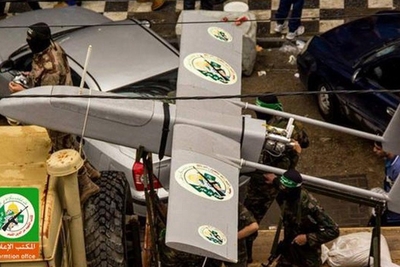|
|
|
|
Steven Emerson,
Executive Director
|
July 16, 2018
|
|
|
IDF:
Hamas Plans to Strike Israel with Exploding Drones
IPT News
July 16, 2018
|
|
|
|
Share:  
|
  Be the
first of your friends to like this. Be the
first of your friends to like this.
 As Israel moves more Iron Dome anti-missile batteries to its
border with Gaza, Hamas terrorists are moving forward with plans to spread
their arson-by-air attacks deeper into the country. Israel held an
emergency cabinet session Sunday after another Hamas provocation over the weekend.
Israel's military hit dozens of Hamas targets in Gaza after terrorists launched an estimated 200 missiles at Israeli
communities on the border. As Israel moves more Iron Dome anti-missile batteries to its
border with Gaza, Hamas terrorists are moving forward with plans to spread
their arson-by-air attacks deeper into the country. Israel held an
emergency cabinet session Sunday after another Hamas provocation over the weekend.
Israel's military hit dozens of Hamas targets in Gaza after terrorists launched an estimated 200 missiles at Israeli
communities on the border.
According to Palestinian media reports, Israel also deployed three drones to strike Palestinians launching
incendiary kites and balloons, wounding three terrorists.
"It's important to emphasize that we have no intention of
tolerating this – not rockets, not kites, not drones – nothing,"
warned Israeli Defense Minister Avigdor Liberman during the cabinet
meeting.
For years, Hamas has been diverting resources intended for civilian
re-building efforts in Gaza to enhance its military capabilities, including
a growing drone program. Hamas, like other terrorist groups, has used drones for a
variety of purposes including attacks, reconnaissance, and testing state air defenses. In the past, Hamas has deployed several drones to infiltrate Israel and
exploited these incidents as propaganda victories. Now Hamas may have found
another potential use for drones: to enflame its arson terror campaign.
Looking beyond incendiary kites and balloons, Israeli defense officials
believe that Hamas wants to deploy exploding drones to increase the
organization's arson-based terrorist efforts.
According to an Israel Hayom report, Hamas is preparing to mount explosive material
on unmanned aerial vehicles to target Israel communities situated deeper into
the country. The terrorist group has also already started to affix timers
to incendiary aerial devices, to delay their detonation and maximize damage
to Israeli land.
Public Security Minister Gilad Erdan warned that "we are seeing an
obvious trend" and that Hamas operatives "are constantly
increasing their kites' range and they are using other airborne devices" which "may
even reach Judea and
Samaria (West Bank)."
Previous reports pointed to Iran building a fleet of suicide drones for its main terrorist proxies,
including Hamas, to assemble and launch kamikaze style attacks. But Hamas
also maintains an increasingly sophisticated domestic drone program as well.
Israel's national security is threatened by several militant groups with
established drone programs on its borders, including
Hizballah, the Islamic State, and al-Qaida's affiliate in Syria. Even
Iran's Islamic Revolutionary Guard Corps (IRGC) now threatens Israel directly by deploying drones into its
airspace to test Israel's resolve.
Like Iran, Hamas is attempting to create "new rules of
engagement" in its war against Israel. The terrorist organization
recognizes that Israel's military will likely avoid direct responses
against terrorist cells launching incendiary aerial devices into Israel
territory.
Israel's air force struck several Hamas military targets after
terrorists deployed incendiary kites and balloons that caused severe fires
in Israeli communities on the Gaza border. Hamas escalated the violence
last month by launching 45 mortar shells and rockets at Israel.
Similar tit-for-tat incidents have emerged since Hamas began encouraging
and planning this new method of arson terrorism during the violent border riots on the Gaza border at the end of
March.
Many of these devices continue to land on Israeli territory, sparking
destructive fires that burn thousands of acres of crops and natural forest
area. Containing the fires is a major strain on Israel's resources and significantly
disrupts civilians' lives. Israel has largely relied on firing warning
shots at Palestinians launching incendiary devices.
On Sunday, Israel's security cabinet directed the military to adopt tougher countermeasures
against Hamas' use of arson terrorism. But considerable debate within
Israel's security establishment remains on how to tackle the threat.
In a reportedly heated exchange on Sunday, IDF Chief of Staff Gadi
Eisenkot challenged Education Minister Naftali Bennett's push to allow the
military to directly target cells launching incendiary aerial devices – a
more aggressive policy than the current use of warning shots. Eisenkot
allegedly argued that lethal force in this situation is immoral.
Israel has increasingly relied on drones in an attempt to take down incendiary kites and
balloons. There may be an emerging "drone, counter drone"
struggle between Israel and its terrorist enemies – similar to the dynamic between the United States and global jihadists.
To address the wider UAV terrorism threat, Israel has reportedly
assassinated key drone experts abroad, while continuing to target enemy UAV storage facilities in airstrikes and
intercepting shipments of UAV-related material to terrorist organizations.
UAV terrorism will grow as the technology becomes less expensive and
more effective. A sophisticated militant organization should have no issues
launching explosives-laden drones. The Islamic State, for example, deployed
its first suicide drone attack using a modified commercial UAV.
Amid Hamas's new provocative strategy, Israel will continue evolving its
efforts to counter emerging terrorist threats – including drone-based arson
attacks.
|
The IPT accepts no funding from
outside the United States, or from any governmental agency or political or
religious institutions. Your support of The Investigative Project on
Terrorism is critical in winning a battle we cannot afford to lose. All
donations are tax-deductible. Click here to donate online. The
Investigative Project on Terrorism Foundation is a recognized 501(c)3
organization.
202-363-8602
- main
202-966-5191
- fax
|
|































No comments:
Post a Comment